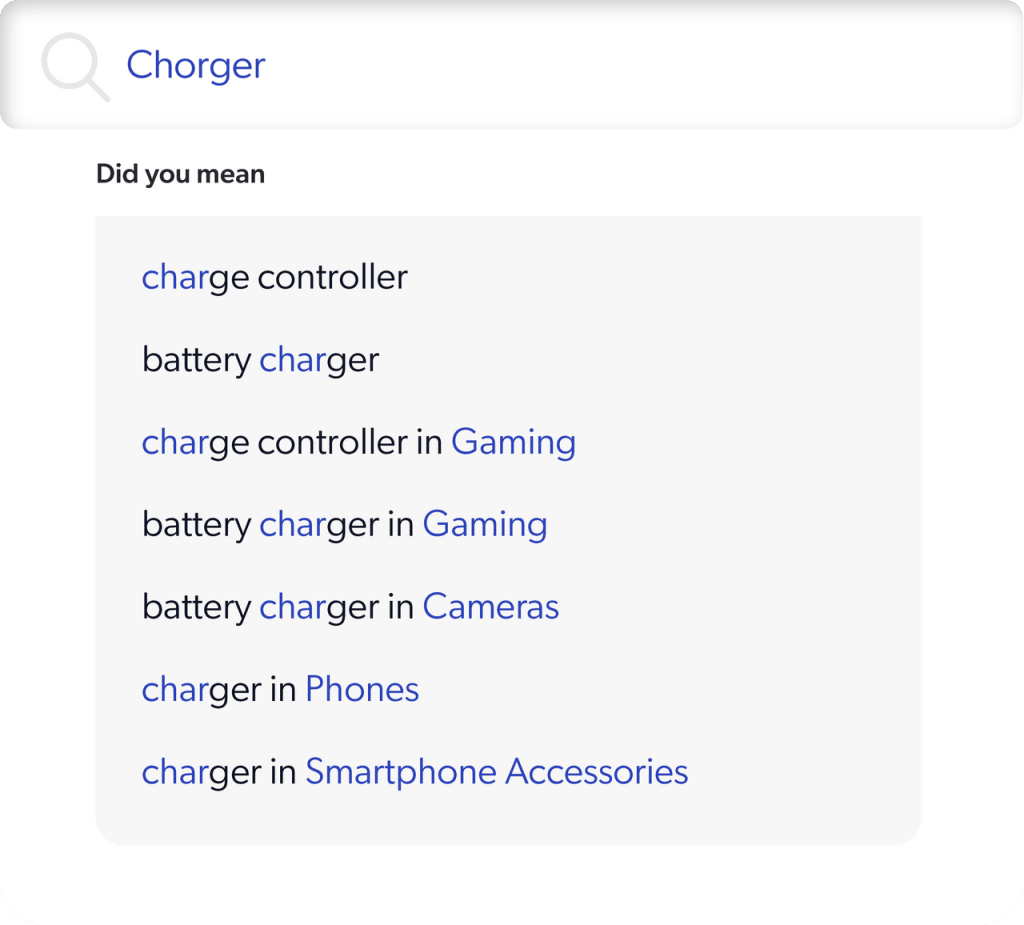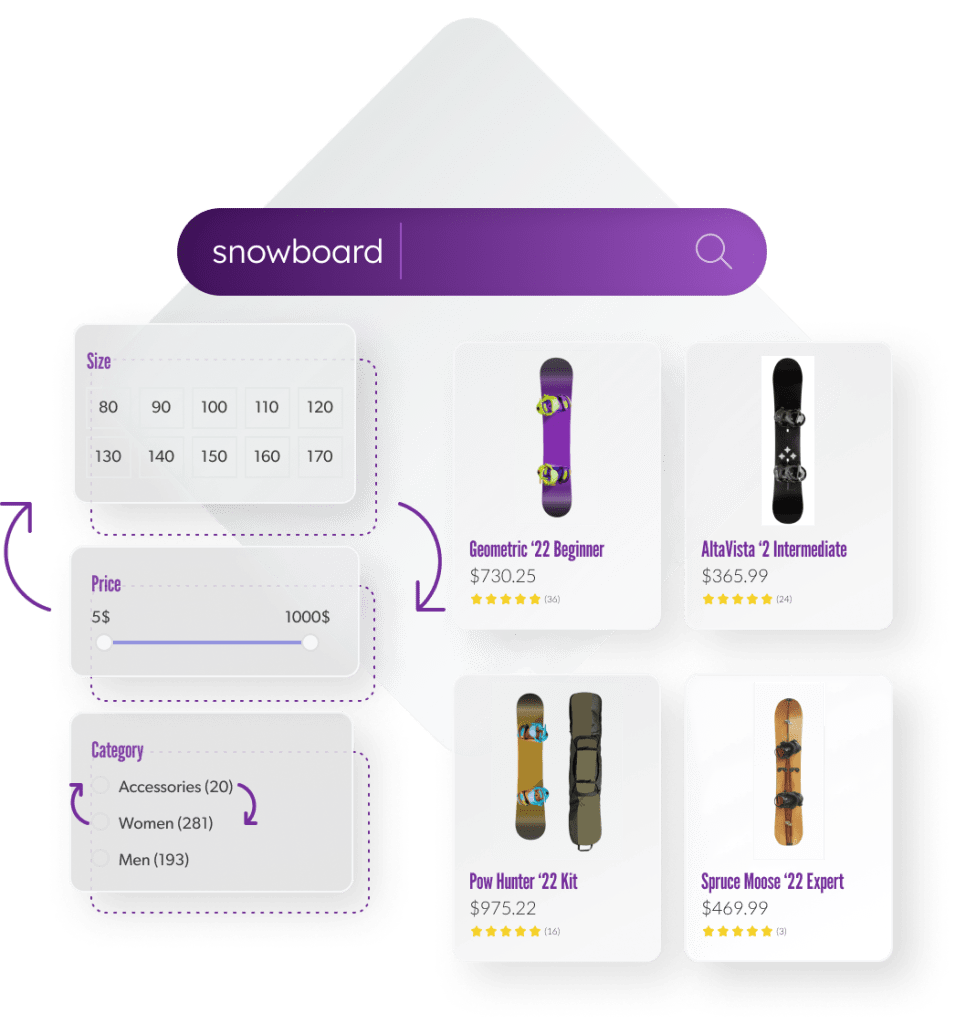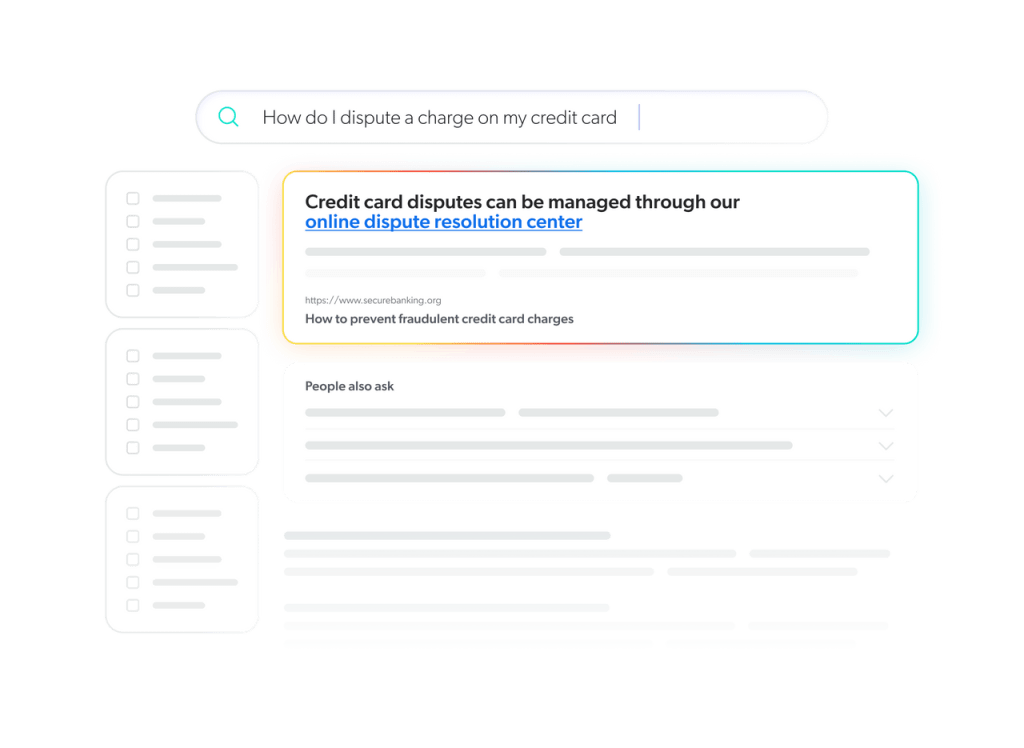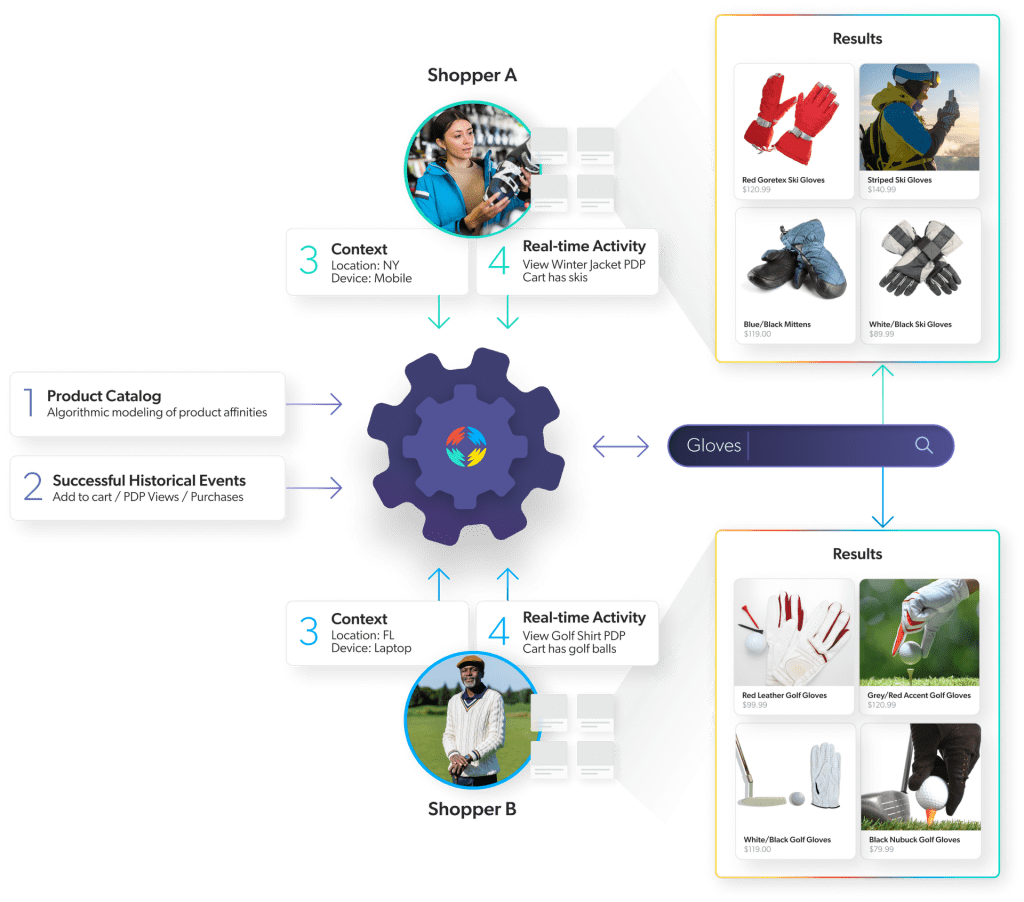User intent – or searcher intent – refers to a user’s underlying objective or goal when searching. It’s a way to classify an individual’s purpose behind a search query.
Another way of thinking about this is as the task they are trying to accomplish through their search. Broadly, their intention is to learn something (Informational), find something (Navigational), or buy something (Commercial/Transactional).
When marketers talk about personalizing the customer journey, we tend to focus on outbound channels like email, chat, and website — the things we’re saying to our customers. But tapping into what customers are looking for, whether that’s on a web search engine or your own site, is a powerful way to connect with your audiences.
Plus, searches on your site represent a high-intent activity that you don’t want to lose out on.
If you’re looking to deliver tailored results that meet individual customer needs, AI-powered search that takes user search intent into account can help.
Why Should You Care About User Intent?
Well, if you’re here, you’re likely a marketer looking to better understand how you can improve website conversions.
Most of the time, that conversion energy is focused on outbound campaigns. One overlooked area is inbound marketing. And there are numerous ways site search can be an inbound marketer’s best friend.
When people find — or come back to — your site, they’re looking for product or information that satisfies their needs. When they conduct a site search, that search shouldn’t just turn up content that matches the words they put in the search box. It should match the intent behind those words
A search engine identifies what a user wants based on four common types of search intent:
- Informational intent: An informational query tries to find informational content about a topic that may or may not be tied to a specific product or service. An informational keyword search can be broad or specific (e.g., “cake making tips” versus “how to bake a red velvet cake”).
- Commercial intent: Commercial search intent is a subset of Informational that focuses on finding more details about a product or solution they want (e.g., “best hiking boots”).
- Navigational intent: This type of user intent focuses on finding a specific site or page. Navigational searches typically target a destination like a social media login page, hub site, or specific website.
- Transactional intent: The intent with a transactional search is connected to the user’s readiness to buy or convert. They have done their research and are at the decision/buying stage (e.g., “buy Apple AirPods”).
Why User Intent is Tough to Discern
As we noted above, search intent is often ambiguous, making it difficult for a search engine to personalize a visitor’s experience by recommending relevant content. For example, a user may search for “laptops” with informational intent (they want to learn more about laptops) but then click on a laptop page and buy one, showing transactional intent.
When someone searches for “mountain bikes,” are they looking to buy? Are they researching how to fix one? Or do they want to sell one? Understanding user intent helps marketers and content strategists understand the types of content they need to have. (Ostensibly articles that explain all of the above on mountain bikes!)

Traditionally, search personalization required historical data, user profiles, and more.
But what about when you don’t have much information about a user? This is where session-based personalization can address challenges when it comes to interpreting intent, including:
- User intent can change over time. Without historical data, it’s difficult to understand where a user is in their buying or informational journey since the algorithms can only see what is happening in the current session. This can be limiting for some search platforms.
- As the “laptop” example demonstrated, keywords can have different interpretations. User intent doesn’t always equal purchase intent when someone searches for a product.
- User signals can be influenced by external factors like location (e.g., local intent), time of day, and device type which can make user intent around a specific search term or keyword query hard to interpret.
- A user’s search intent tends to be informed by their past search activity, browsing behavior, and interactions on external websites, but this data may not be available. Again, limits for some search platforms.
During a single search session, there is still data — and that can be used to personalize their session.
How User Intent Fuels Your Content Marketing Strategy
Search analytics tools can help you identify the keywords people are using to find your site, but they don’t provide much information about searcher intent. When you understand the common types of search intent that drive different queries (e.g., “trail running tips” versus “best trail running sneakers”), you can plan a more deliberate digital marketing and content approach.
One example of how understanding user intent helps with planning is keyword research. Tools like Google’s keyword planner (or your own search analytics) show keyword volume and provide a list of similar search terms that people use when conducting a search. This is a good starting point when coming up with a content strategy, but it doesn’t give you much more than a target keyword (or keywords) to work with.
Using machine learning to tie intent to user profile data and activity helps you personalize information for your targeted audience. So if someone is researching eggplant-based recipes, they wouldn’t get egg related content — but a wider, broader recommendation that’s specific to them, such as vegetarian and non-meat options.
Understanding the different types of search intent also helps inform content creation. A user’s search intent changes based on where they are in their buying journey. Recognizing this and incorporating it into the content you create allows you to personalize your content approach across all stages of that journey.
As we’re about to discuss, it also enables intelligent search engines to surface the most appropriate content to the most appropriate user based on elements that go beyond relevant keywords and include factors like user behavior data, historical data, interests, and more.
How to Fulfill User Intent With AI Search
AI search can provide dynamic personalization that adjusts to a user’s search results based on their behavior (e.g., behavioral data ), interests, and search history. This is called “small data personalization.” Rather than relying on large amounts of user data, AI search uses small data personalization to combine things like user intent, keyword phrase analysis, journey analysis, predictive analytics, and natural language processing to produce a customized search result in real time.
Personalization happens when the search engine studies in-session user-specific signals to provide individualized search results and recommendations.
Personalized search looks different for different businesses and use cases, but the goal is always to deliver the most relevant results possible based on an individual customer’s search intent. Here are some use cases that demonstrate what that might look like across different industries.
What small data personalization looks like across industries
Healthcare
A user visits a healthcare provider’s website but isn’t a patient yet. They browse provider pages, scan the page about what insurances are accepted, then do a search for some symptoms they’re experiencing. This is an example of informational search intent – the searcher wants information about their medical condition. Customized search results could include a list of providers who accept their insurance, articles and resources about their symptoms, and links to FAQs covering topics the user was browsing about.
Retail
A shopper visits an online retailer’s website for the first time. They browse the shoe selection, click on a product page about running shoes, then do a search for “running shoes”. This search might have multiple intents including the intent to buy (a transactional query) or they may just want to know what shoes are available (a commercial query). Customized search results could include running shoe selections that match their preferences, along with recommendations for related items like socks and apparel.
Car Insurance
A user visits a car insurance website and does a search for “auto insurance”. Again, this query can have multiple search intents including the intent to buy or just a quest for more information. Customized search results could include an overview of coverage types, tips for saving on premiums, and recommendations based on the user’s location.
Workplace
An employee opens their browser and types “Acme Intranet Login” in their computer’s search bar to pull up a link to the intranet login page. This is an example of a navigational query – the employee is using search to go directly to a specific page. Once logged into the intranet, the employee does a search for “employee benefits”. Customized search results could include geographical area, user-specific benefits, FAQs about their specific role or department, and relevant forms.
Service
A potential customer visits an auto service website and does a search for “oil change near Fresno”. This is a local search query with both commercial and transactional intent. Customized search results could include locations near the user, company reviews from customers who’ve gotten oil changes, and recommendations based on the user’s make or model (if this information has been entered as part of the search).
6 SERP Features to Satisfy User Search Intent
Session-based personalization provides a unique opportunity to personalize for user intent without requiring personal information or historical data about a user. To achieve this, a dynamic search personalization engine looks at the following criteria:
UI Feature: Auto-complete and auto-correct
User signals can include query suggestions using autocomplete and autocorrect. The search uses the context of your website and analyzes browsing history and other signals like search queries from the same session.
For example, if you sell craft supplies and a user who’s been browsing knitting patterns begins typing “cot” the query might autocomplete as “cotton yarn for knitting.”

UI Feature: Predictive categories
User browsing behavior also informs user intent and provides clues about what the user is looking for. An AI-driven personalization platform can use machine learning to suggest appropriate categories based on a user’s query.
For example, if someone’s been reading about launching a social media campaign on a marketing agency’s website, and then searches for “paid Facebook ads” the system could suggest they visit the “Paid Media Planning” category to find more information.
UI Feature: Faceted search
Search facets are another feature that users have come to expect in their digital experience. They make it much easier for users to navigate on mobile websites. They work by filtering broader search queries into more specific categories and can be displayed as relevant tags – or facets – alongside the user’s search results.
Search facets help users quickly narrow down search parameters to find what they want. For example, if a user searches for “snowboard” they might see faceted search tags like “size”, “price”, and “category.”

Relevant reading: The Complete Guide to Designing Faceted Search
UX Feature: Natural language processing (NLP)
Natural language search, an application of NLP, goes beyond search intent signals by using relevant information to derive meaning from queries, recommend synonyms, and matching phrases.

Relevant viewing: Natural Language Search, What’s All the Hype?
UX Feature: Time and location
A user’s current location and time of day can influence user intent. By understanding the context of time and place, it’s easier to determine what content might be most relevant for that user.
For example, a user in Israel who is searching for round trip airfare to South Africa on an airline’s website would get different results than a user conducting the same search from California.
Understanding and reacting to these signals allows website tailoring on a level that says to a site visitor, “I get you.”
UX Feature: User clustering
AI search can also make an “educated guess” about user intent by using refined similarity models to predict a user’s intent from their in-session real-time browsing behavior.
The system applies a temporary ID to anonymous users (e.g., people who aren’t logged in), and analyzes the information gathered during the session.
For example, a contractor on a home improvement retail site may be reading about how to ship industrial materials and then do a search for “tool rental”. The results would be geared toward professional contractors (e.g., pro equipment rentals versus DIY rentals).
Give Users What They Want With AI Experiences
By using AI search and leveraging intent signals from users’ current context and activities on your website, dynamic search personalization provides users with relevant, personalized results without relying on user profiles and historical data. This not only helps you meet rising customer expectations around good online experiences, it opens the door for new opportunities around user engagement, interaction, and conversion.
Combining user intent signals with AI-driven user personalization allows you to deliver better user experiences on your website in real time without massive user data sets and complex workflows. You’ll have the ability to provide a truly personalized search experience for your visitors that meets their needs more quickly and accurately than ever before.
Learn how to apply user intent in our on-demand webinar, 5 Best Practices for AI-Powered Site Search.
Dive Deeper
Personalization can drive substantial revenue lifts. But the tension between personalized experiences and privacy is increasing, with a growing segment of shoppers not agreeing to the usage of cookies.
Learn how to balance the two with our handy infographic.



